How a cesspool is constructed in a private house: a review of structures + rules for their arrangement
If a person lives in a house, there should be a sewage system in it, since waste products still need to be removed somehow. And it's hard to disagree with that, right? Modern industry offers many solutions: from multi-section septic tanks to neat dry closets. But the usual cesspool in a private house is still relevant and in demand.
But, before you start the construction of a cesspool on the site, you will have to weigh the pros and cons. After all, the wrong place, and the very design of the cesspool, subsequently, threatens to turn into many problems. The most common of them is the appearance of an unpleasant odor. We will tell you how to avoid this problem.
In the article, we collected and summarized information about the types and design features of cesspools. In addition, here you can find useful tips and tricks on how to choose and build sewers on the site. The material is accompanied by thematic photos and videos.
The content of the article:
Device and design types
A cesspool is perhaps the oldest and simplest type of sewage system. It is a recess in the ground in which sewage is accumulated and partially processed.
Any effluent contains a certain amount of bacteria that absorb and transform these accumulations. Part of the filtered effluent passes into the underlying soil.
Anything that has not been processed or left for the underlying layers should be periodically removed from the cesspool so that the container does not overflow.
In summer cottages, they often arrange a separate cesspool for the toilet. It looks like a relatively small depression in the ground, over which a light wooden structure is installed.
When the hole is filled, the toilet is cleaned, the recess is covered with earth. Waste decay in the soil and turn into compost - a useful fertilizer.
In the future, a fruit tree is planted at this place, which will give an excellent harvest in such a well-fertilized place. And for the toilet they dig a new hole, which is then disposed of in this way.
But for the needs of a large house, especially with year-round living, such a solution, of course, is not enough.
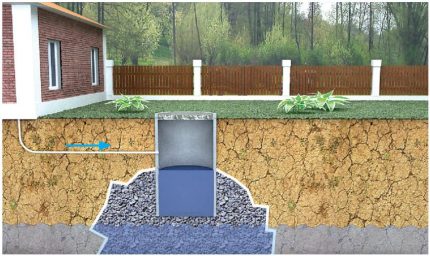
Modern cesspools have a fairly large volume, and their walls are constructed from a wide variety of materials.
It could be:
- brick;
- aerated concrete blocks;
- wood;
- concrete rings;
- old tires, etc.
For the device of the simplest cesspool, you can now buy ready-made plastic container with sunroof and sturdy walls.
With its help, the process of constructing a mini-sewage system in a suburban area is significantly facilitated and accelerated significantly.
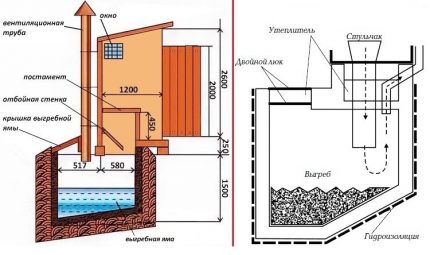
When choosing material for a cesspool, it should be borne in mind that prolonged contact with an aggressive environment will gradually destroy its walls. To extend the life of the structure, you need to choose materials resistant to such an impact.
There are two types of cesspools: sealed and filtering. In the first, effluents are accumulated and stored until pumping. Secondly, there is no bottom in the traditional sense of the term, and there may be holes in the walls so that part of the waste enters the ground.
If it is supposed to filter effluents through the walls of the structure, then a gravel-sand filter with a thickness of at least 15 cm is arranged around them.
Walls filtering facilities make either monolithic or perforated, depending on the filtration qualities of the containing soils and the tasks of wastewater treatment.
Structures with the possibility of infiltration into the surrounding soil are suitable mainly for drains collected by drainage and storm sewers.Between the conditional bottom of such a structure and the underground water mirror there should be a thickness of soil with a thickness of at least 1 m.
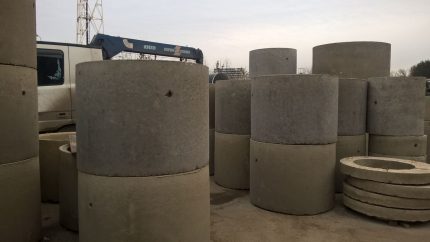
A cesspool with a sealed bottom and monolithic walls is arranged for the collection and subsequent removal of domestic and household wastewater.
It is also needed when there is a high occurrence of groundwater, because in such situations it is necessary to exclude direct communication of effluents with the environment.
Leak-proof pits of a large volume, in which it is supposed to accumulate a large number of drains in a short time, must also be sealed. A significant amount of waste will be processed for too long, the risk of soil pollution increases.
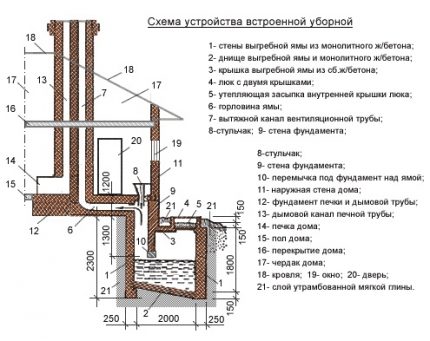
Design and Preparation Principles
Even such a simple structure as a cesspool, requires competent preparation and planning. It is necessary to determine a suitable place for its arrangement, to choose the type of structure, its dimensions, technology of work, materials, etc.
The location of the cesspool is a critical moment. According to building codes, it should be located at a distance from fences, residential buildings, etc.
For example, from a well with drinking water, this sewer should be at least 25 meters away, and from a residential building - at least five meters.

If the relief on the site is uneven, you should not arrange a cesspool in the lowland. During the spring flood, it can with high probability be flooded, and this will lead to groundwater contamination in the area.
The volume of construction depends on the number of residents in the house and the time of residence. For one person usually take from 0.5 to 2.0 cubic meters. m
It is better if the volume of the structure is a multiple of the capacity of the machine of the scavengers, since the fee for the use of equipment usually does not depend on the number of drains, the cost of each exit is paid.
Thinking over the place for placing the cesspool, you should immediately take care the problem of cleaning it. The easiest and quickest way to perform this unpleasant procedure is with the help of a scavenger machine. Therefore, for the passage of such equipment should provide sufficient space.
It also happens that the standard site for the cesspool does not allow the use of a cesspool machine. Accumulated drains in this case are removed using a special pump or an ordinary bucket.
The pit is sealed or with holes for filtering. The choice is affected by the level of groundwater in the area.If it is less than a meter, the pit must be completely tight.
Otherwise, runoff can penetrate the aquifer and adversely affect the quality of the water. To restore its normal composition in such a situation will not be easy.
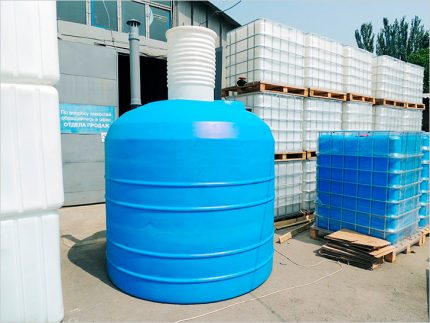
To equip a sealed cesspool, the bottom is concreted, the walls of the structure are made without gaps. An alternative is a plastic container installed inside the pit.
It will also provide the necessary tightness, but it should be remembered that the strength of plastic is significantly inferior to concrete or brick.
If the first aquifer from the surface lies 1 or more meters below the bottom of the pit being constructed, then it can be arranged on the principle of a filter or absorption well.
The bottom of the pit is formed from a material with high filtration properties: sand, gravel or gravel with sand aggregate. The power of the filter backfill is at least 1 m.
It makes no sense to arrange a filtering structure on rock and semi-rock formations, loams and clays, as Recycled wastewater simply cannot migrate further into the ground.
It is also not done if it is possible to discharge into open water bodies near bathing places or water intake points for technical purposes.
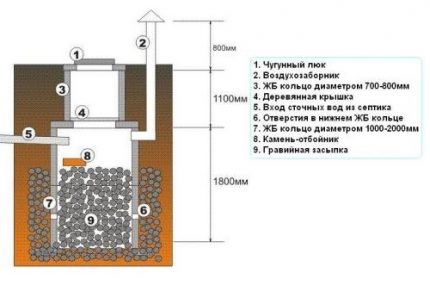
For a small family of three people there are national standards for the construction of cesspools. Arrange them at the rate of 0.5 m3 on one face, on average 1.0 - 1.5 m deep, 0.8 - 1.0 m wide.
If a small-sized closet rises above the cesspool for summer residents who do not live permanently on a suburban area, the standard sizes and the estimated volume can be slightly reduced.
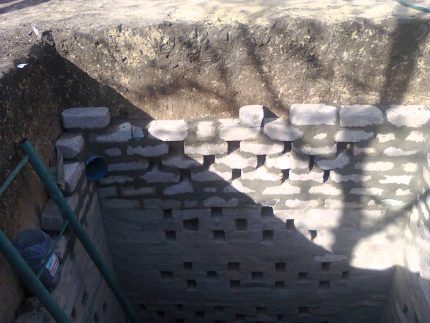
Features of the installation of cesspools
So, the place has been chosen, it's time to start the construction of the pit. Usually, special equipment is used for this, since it is too long and difficult to take out large volumes of soil manually. Pit configuration may be square, rectangular, round - it all depends on the selected material.
Under old tires, concrete rings etc. need a round pit.
It is more convenient to fill with concrete or the erection of wooden walls in a square or rectangular pit. And here brickwork can be performed both in a circle and in a straight line.
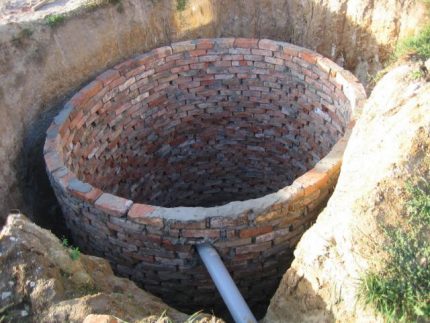
After the pit is ready, you need to start arranging the bottom filter from a compacted mixture of crushed stone with sand. Over time, crushed stone is poured into the pit if a part of the filter material is squeezed out under the weight of the effluents into the underlying layer.
If you need a sealed pit, the bottom is made in the form of a concrete screed as for the foundation. Then the walls are erected. You can continue to work with concrete, make formwork and fill the walls.
It is easier and faster to make a sewer from concrete rings. They are installed in the pit, and then they are sealed and sealed.
A plastic container is placed on a compacted sand cushion. In this case, filling the pit should be done very carefully so as not to damage the plastic. It is recommended that water be poured into the container at the same time to balance the pressure inside and out.
The quality of the brickwork in the sewer construction is not particularly stringent, the result will be hidden underground. This work can be completely entrusted to a novice mason.
But still, it should be remembered that even in the sewers, too curved walls are not needed. This increases the likelihood of their destruction under the influence of external factors.
Normal brickwork will provide sufficient tightness to the structure. If it is planned to create a cesspool with natural filtration, a gap of about half a brick is left in the joints.
By agreement with local inspection bodies, in rare cases it is permissible to build a cesspool of wood. It is recommended that wood be pretreated with special materials to increase its life.
As practice shows, wooden cesspools do not last long and in a few years may need repair.
For waterproofing, the gaps between the logs are caulked and oiled, and a clay waterproofing layer of 45 cm thick is applied to the bottom and walls. The top of the cesspool is covered with densely laid logs, and for the possibility of pumping out drains, a hatch of about 80 × 70 cm is arranged.
And another option for decorating the walls of the cesspool is old tires. They are stacked in a pit in a pile to protect the walls of the pit from destruction. Of course, we are not talking about any special tightness in this case.
This is a temporary option that does not provide a large volume for the accumulation of effluents. But making a pit out of tires is relatively easy, and it performs its functions quite satisfactorily.
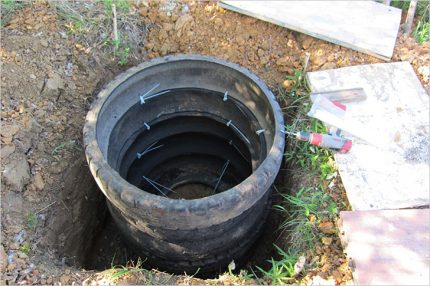
The nuances of operating cesspools
If the cesspool is arranged correctly, there will be no big problems with its operation. The main problem is the regular cleaning of the tank from accumulated effluents. Do not wait until the tank is full, the removal of effluents should be started earlier.
However, a simple pumping of sewage does not make the building clean automatically.In cesspools over time, phenomena such as siltation of the bottom and contamination of the walls with fatty deposits are observed.
All this leads to a reduction in the volume of the structure, it is filled faster, and it is necessary to call the scavengers more often.
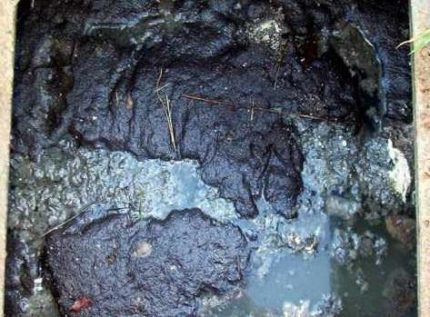
In addition, pollution enhances the already appetizing odors characteristic of the sewage system. One way to solve the problem is to use special bacteria for cesspools. These microorganisms are simply poured or poured into a container in accordance with the manufacturer's instructions.
The presence of bacteria helps to speed up the processing of effluents and prevents the likelihood of contamination of the surrounding soil. In addition, microorganisms can significantly weaken and even completely eliminate unpleasant odors of sewage.
Before using bacteria, you should carefully study the instructions. Such drugs are not always compatible with some types of household chemicals. You need to choose a different composition or change the means for cleaning, washing and other needs to more suitable.
Sometimes bacteria do not help, the walls and bottom of the tank are covered with deposits. In this case, mechanical cleaning of the tank will help. After pumping wastewater, a worker descends into the pit, who cleans the dirt from the walls.
Then, a layer of sludge is removed from the bottom. The cleaned bottom should be covered with a fresh layer of gravel or gravel.
Work on cleaning cesspools is not only time-consuming, but also dangerous. They should be carried out in special protective clothing and a respirator. Safety glasses and, of course, gloves do not interfere. It is not recommended to perform such work alone.
Deposits can emit gas that is hazardous to human health. A worker inside the pit may suddenly lose consciousness under the influence of such fumes. Even if two or three people work below, they should be insured by someone on the surface in case of such a nuisance.
Concrete ring cesspool
The use of prefabricated reinforced concrete structures, in this case, concrete rings, significantly speeds up construction, so they are used quite often. Such elements can be used to equip both a sealed and an absorbing cesspool.
In the first case, monolithic rings are taken, and in the second, special rings with holes are used.
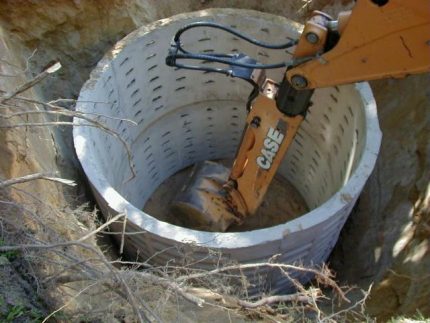
Of course, whole elements should be used without cracks, so that the structure does not collapse during operation.
To make a cesspool of concrete rings, you must follow these steps:
- Choose a place for construction.
- Make markup.
- Dig a pit.
- Flatten the bottom.
- Pour the bottom of the pit with a concrete screed.
- Install concrete rings.
- Lay the necessary sewer pipes.
- Close up the seams.
- Carry out waterproofing and sealing work.
- Fill the foundation pit.
- Install concrete slab with hole and cover.
- Install ventilation structures.
Of course, there is no need to concrete the bottom for an absorbing cesspool. Instead of screed, a layer of gravel or crushed stone should be put to the bottom to improve the drainage of the structure. And for a sealed structure, you can find a ready-made concrete ring in which there is already a bottom. But such options are not common.
The bottom is concreted with a screed about 10 cm thick. To add extra strength to the layer, crushed stone is added to the composition. the solution should be as homogeneous as possible in order to achieve uniform drying.
Until the screed is dry, it is impossible to continue work on arranging the cesspool. Have to wait at least a week.After drying, flaws may appear on the screed - cracks, bumps, etc. They must be eliminated using a special repair solution.
Concrete rings should be installed very carefully. This can be done using a crane or manually. The joints are sealed with rubber gaskets, old car cameras can be used. At the joints, the rings are isolated with a solution.
From the inside cesspool waterproofing It is recommended to perform using liquid glass.
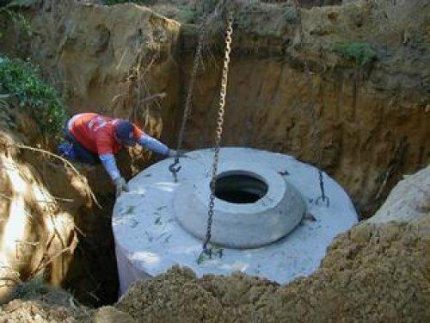
For sewer pipes dig a trench with a slight slope - about 3 degrees. The recommended depth of such a trench is at least one meter so that the pipes do not freeze in winter. For the same purpose, pipes are covered with a layer of heat-insulating materials.
The hole in the concrete ring for connecting the sewer pipe can be made using a punch.

After the pipes are laid, the quality of work is checked by lowering a little water into the sewer. After making sure that there is no leak, you can begin to backfill the trench. As a top floor, a reinforced concrete slab is usually used.
It is best to choose a design that already has a round or square hole for maintenance. This hole is closed with a standard cover.
Good ventilation of the cesspool helps improve waste management and remove unpleasant odors. For ventilation in the upper ceiling, it is imperative to make a special hole and bring up the pipe.
A plastic pipe with a diameter of at least 100 mm is suitable. On top of it, it is necessary to cover it with a special deflector in order to prevent the penetration of sediments into wastewater.
Conclusions and useful video on the topic
Here is a detailed overview of the arrangement of cesspools made of various materials:
An interesting version of a cesspool paved with bricks is presented in this video:
In this video, you can see a clear example of installing a cesspool of concrete rings:
The cesspool is an ancient, but useful construction. This is the easiest and relatively cheapest way to provide a reliable autonomous sewage system..
It is only necessary to choose the right place, determine the volume and precisely observe the technology of work.
Do you know the secrets of arranging an autonomous sewer with a cesspool? Perhaps you recently built a drive for sewage from improvised materials with your own hands? Tell us about it - your experience may be useful to other owners of suburban housing.

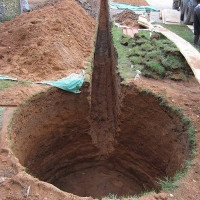 How a cesspool is constructed without a bottom: schemes and arrangement rules
How a cesspool is constructed without a bottom: schemes and arrangement rules 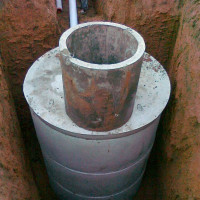 How to construct a cesspool of concrete rings: schemes + step-by-step guide
How to construct a cesspool of concrete rings: schemes + step-by-step guide 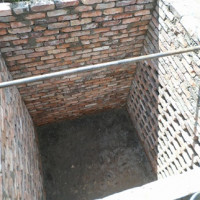 How to build a drain pit of brick: options and methods of arrangement
How to build a drain pit of brick: options and methods of arrangement 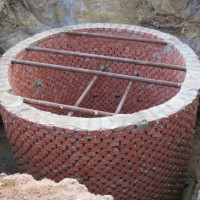 Do-it-yourself cesspool: analysis of popular options for arranging
Do-it-yourself cesspool: analysis of popular options for arranging 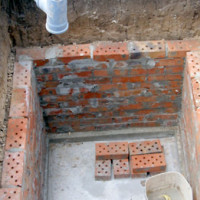 Do-it-yourself pit in a private house: how to dig and equip yourself
Do-it-yourself pit in a private house: how to dig and equip yourself 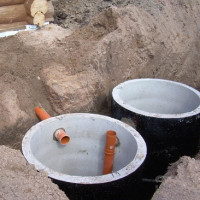 How a cesspool with overflow is arranged: schemes and construction technology
How a cesspool with overflow is arranged: schemes and construction technology  How much does it cost to connect gas to a private house: the price of organizing gas supply
How much does it cost to connect gas to a private house: the price of organizing gas supply  The best washing machines with dryer: model rating and customer tips
The best washing machines with dryer: model rating and customer tips  What is the color temperature of light and the nuances of choosing the temperature of the lamps to suit your needs
What is the color temperature of light and the nuances of choosing the temperature of the lamps to suit your needs  Replacement of a geyser in an apartment: replacement paperwork + basic norms and requirements
Replacement of a geyser in an apartment: replacement paperwork + basic norms and requirements
I didn’t bother at all in the country: I dug a hole, built a wooden booth and that’s all - the toilet is ready. But when the parents bought the house, I already dealt with this issue more seriously from them. We dug a wide pit, ordered concrete rings. They installed everything, built a toilet. A couple of times a month a car arrives and exhausts everything. Cheap and cheerful, and I see no reason to unnecessarily complicate this system.
I did not dig a hole under the street toilet, but as a filtering well for the “gray” sewage system. An equipped toilet with a cesspool was in the house, it was necessary to dispose of dirty water from the kitchen, sinks and shower. Just from the house into the pit held a wide plastic pipe at a slight slope towards the drain. I was lucky with the fact that I dug into the sand, which began to absorb all the waste, I had to clean the pit much less often.
The absorption pit itself is about five meters deep and 1.5 to 1.5 meters wide. And from above I knocked down a wooden frame and covered the entire system with the usual wavy slate. It’s a very practical option, from time to time I look there to control when it will be necessary to remove the sediment deposited on the soil filter.
Is the pit deep? Five meters only for gray drains, how many people is it designed for? I just also need to dig a hole in the country to drain domestic wastewater, but I planned a meter and a half maximum.
Hello. In general, most sewage machines do not reach drains from a depth of more than 3 meters.
Daniel was lucky on the sand and in addition, he does not drain solid drains, silting the bottom and not letting water pass. In deeper pits, sludge can be cleaned, but you will have to dig out the drains with a machine, and then fill up the chemistry for decomposition; Again, in depth, does the machine pump this sludge (it is necessary to clarify the equipment from local dump trucks).
In general, there are many calculations and standards on this topic. For example, it is recommended to make pits with a calculation of the volume of 2 cubic meters per person, while when filling more than a cubic meter per day, it is necessary to equip two-chamber pits according to SNIPs.
Also, the distance from the bottom of the pit to groundwater should be at least a meter.
My friends have a 3 meter drain pit, one and a half and a half. The family has 5 people, three of whom are children. Integrated pit for liquid and solid waste. Pumped out with sludge, 4 years after the arrangement, with the help of a cesspool machine. This is taking into account that the soil at this depth is oily clay. It is difficult to say which pit is suitable for you, here you need to take into account the number of drains per day, the type of soil, and so on.